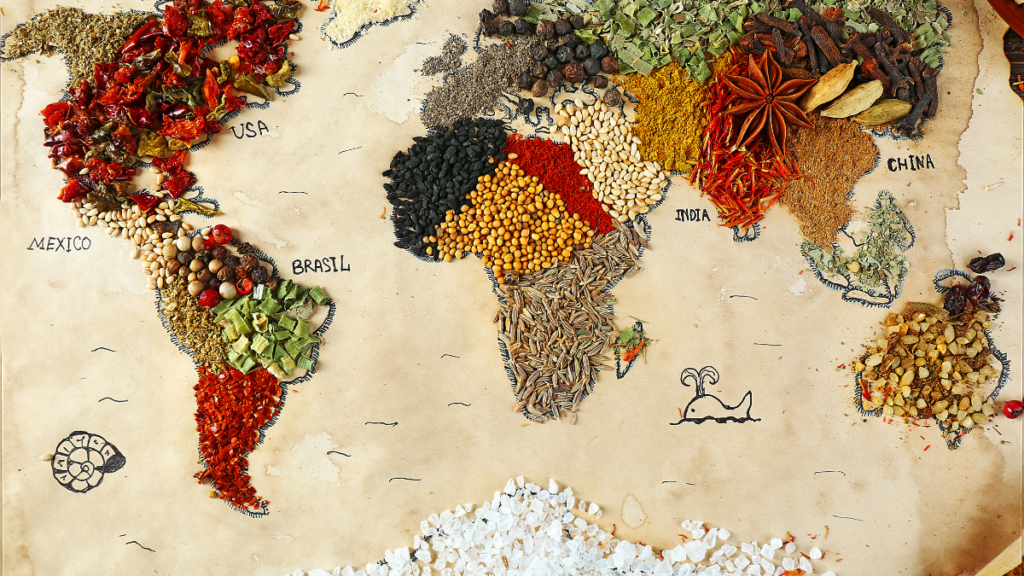India, often referred to as the land of spices, has a rich history in the spice trade that dates back thousands of years. The country’s unique climate and topography contribute to the development of a broad array of spices that have become fundamental to Indian cuisine and cultural heritage. The spice market of India not only serves as a cornerstone of the nation’s economy but also plays a significant role in global trade.
Historical Significance Spice Market of India
Ancient Trade Routes and Cultural Exchange
The ancient spice trade routes, such as the Silk Road corridor and waterways over the Indian Ocean, were pivotal in establishing India as a major player in the global spice market. Indian spices like black pepper, cardamom, cinnamon, and turmeric were highly sought after by civilizations across Europe, Asia, and Africa. These routes facilitated not only the exchange of spices but also cultural and technological exchanges, enriching the societies involved.
Colonial Influence on the Spice Trade
For the most part, the profitable spice trade drove Europeans to colonize India, especially the Portuguese, Dutch, and British. Spice trade routes were a major source of motivation for colonial powers, as spices such as cloves and black pepper were valued equally to gold. A more industrialized and regulated approach to the production and export of spices started during this time.
Major Spice Producing Regions in India

Kerala: The Land of Black Gold
Kerala, an Indian state in the southwest, is well known for producing black pepper, sometimes known as “black gold.” The state’s tropical weather, along with copious amounts of rainfall, makes pepper farming very successful. Kerala is renowned for producing superior cardamom and cinnamon.
Rajasthan: The Kingdom of Red Chili
India’s northwest state of Rajasthan is well-known for producing red chilli peppers. Some of the spiciest chili varietals, like the notorious Bhut Jolokia or ghost pepper, are grown in the hot, dry climate of places like Jodhpur and Jhalawar.
Gujarat: The Hub of Cumin and Fennel
The western state of Gujarat is a significant producer of fennel and cumin seeds. Owing to their unique tastes and digestive qualities, these spices are staples in Indian cooking. Gujarat’s semi-arid environment makes it possible to grow these resilient spices.
Economic Impact of the spice market of India
Contribution to GDP and Employment
The Indian economy greatly benefits from the spice trade, which also creates jobs for millions of people, including farmers, traders, and exporters. India is the world’s largest exporter of spices, which constitute a significant export commodity. Numerous subsidiary industries, like as packaging, marketing, and transportation, are also supported by this industry.
Export Markets and Global Reach
India exports spices to more than 150 nations, with the United States, United Kingdom, Germany, and the Middle East being its main markets. The nation’s standing internationally has improved due to its capacity to produce premium, organic spices. Due to their perceived therapeutic qualities, spices like turmeric are in high demand, especially in regions where consumers are concerned about their health.
Cultural Importance of Spices in India
Culinary Traditions and Regional Cuisines
Indian food is centered around spices, which are used and blended differently in each region. For example, different families use different secret recipes for garam masala, a spice blend that is used throughout North India. Similar to this, curry leaves and tamarind are frequently used in South Indian cuisine to add unique flavors.
Medicinal and Ayurvedic Uses
Spices are used extensively in traditional Indian medicine, especially Ayurveda, and are not just for cooking. Ginger is used to help with digestion and treat colds, while spices like turmeric are prized for their anti-inflammatory and antioxidant qualities. Indian spices are becoming more and more popular around the world as a result of these age-old customs.
Challenges Facing the spice market of India
Climate Change and Environmental Concerns
India’s spice industry is being threatened by climate change. The quality and yield of spices can be negatively impacted by temperature rise, more frequent extreme weather events, and unpredictable weather patterns. Crop types resistant to climate change and sustainable agricultural methods are crucial for reducing these hazards.
Market Fluctuations and Price Volatility
An array of factors, including trade policies, crop yields, and global economic situations, can impact the volatility of prices and demand in the spice market. The necessity for supportive policies and financial tools to stabilize earnings is highlighted by the fact that small farmers are more vulnerable to these shifts.
Future Prospects of the spice market of India
Technological Innovations in Farming
Spice cultivation can become more productive and efficient with the use of agricultural technologies like precision agriculture. A more sustainable and lucrative farming practice can result from innovations like drip irrigation, soil health monitoring, and the use of biofertilizers on crops.
Expanding Organic and Fair-Trade Spices
The demand for fair-trade and organic spices is rising worldwide. India should concentrate on these markets in order to increase its market share. Indian spices may find new opportunities in high-end markets with certification and adherence to international standards.
Conclusion
spice market of India is a thriving and essential component of the nation’s culture and economy. Indian spices have fascinating tastes and health benefits that have drawn people from ancient trading routes to contemporary global markets. The heritage of Indian spices endures as the sector navigates difficulties and seizes new opportunities.
Also Read:- Exploring Longi Mirch The Fiery Spice with a Rich Heritage


